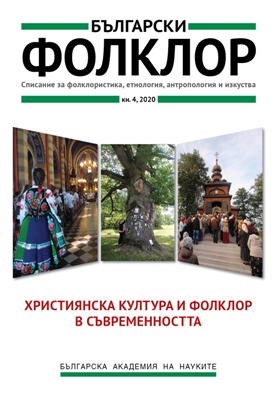Чудотворни мироточиви икони и съвременни поклоннически практики сред православните християни – по примери от Тереспол (Полша) и Шумен (България)
Miraculous Myrrh-Streaming Icons and Modern Pilgrimage Practices among Orthodox Christians – on the Examples of Terespol (Poland) and Shumen (Bulgaria)
Author(s): Daniel FokasSubject(s): Christian Theology and Religion, History, Anthropology, Social Sciences, Fine Arts / Performing Arts, Cultural history, Customs / Folklore, Architecture, Visual Arts, Sociology, Comparative history, Local History / Microhistory, Theology and Religion, Comparative Studies of Religion, Religion and science , Cultural Anthropology / Ethnology, Culture and social structure , Sociology of Culture, Eastern Orthodoxy, Sociology of Religion, History of Religion, Identity of Collectives, History of Art
Published by: Институт за етнология и фолклористика с Етнографски музей при БАН
Keywords: Marian devotion; Mother of God flowing tears; myrrh-streaming icons; miraculous icons; Terespol; Orthodoxy in Poland
Summary/Abstract: A widely popular concept among Orthodox Christians is that religious images as intermediaries between man and God (the Mother of God or the saints) can give material signs of the divine presence on Earth and often do so. First comes the veneration of miracle-working icons, which are connected to narratives of miraculous events and considered the most helpful mediators for prayers addressed to God, the Virgin or a saint. Another popular notion is that icons can miraculously renew themselves or exude holy oil or blood, and give out fragrance. Two cases of largescale myrrh-gushing from the recent years offer different examples of the emergence, development and interpretation of such miraculous events in Orthodox shrines. The first case is from the town of Terespol in Eastern Poland (since 2010) and the second one comes from the town of Shumen in Northern Bulgaria (from 2017). In the Polish case, the myrrh-streaming continued for a long period of time, encompassed other icons as well and was accompanied by stories of miraculous healings. It was approved by the Church as a manifestation of divine nature. All these occurrences gave an impetus to the development of the veneration of the myrrh-streaming icon of the Theotokos Gorgoepēkoos (She Who Is Quick to Hear) and stimulated pilgrimage to the town.In the case from Bulgaria there was also large-scale myrrh-streaming, but it happened only once, at the feast of the Dormition of the Mother of God (15 August). The event was accepted just as a divine sign and was interpreted mainly as given for the sake of penance and strengthening of faith. The fact that no myrrh was gathered and there were no consequent miracles made the Church take a more passive position and the local bishop just unofficially referred to the general Orthodox idea of myrrh-streaming icons.Events of this kind, which were traditionally taken for miracles, often provoke scepticism and doubts of falsification in modern times. For that reason, they are examined by committees appointed by the Church or inspected by bishops, and even submitted to chemical tests. All these processes emphasize the icons’ multifaceted presence in local communities and in society in general.
Journal: Български фолклор
- Issue Year: XLVI/2020
- Issue No: 4
- Page Range: 431-445
- Page Count: 15
- Language: Bulgarian
- Content File-PDF

